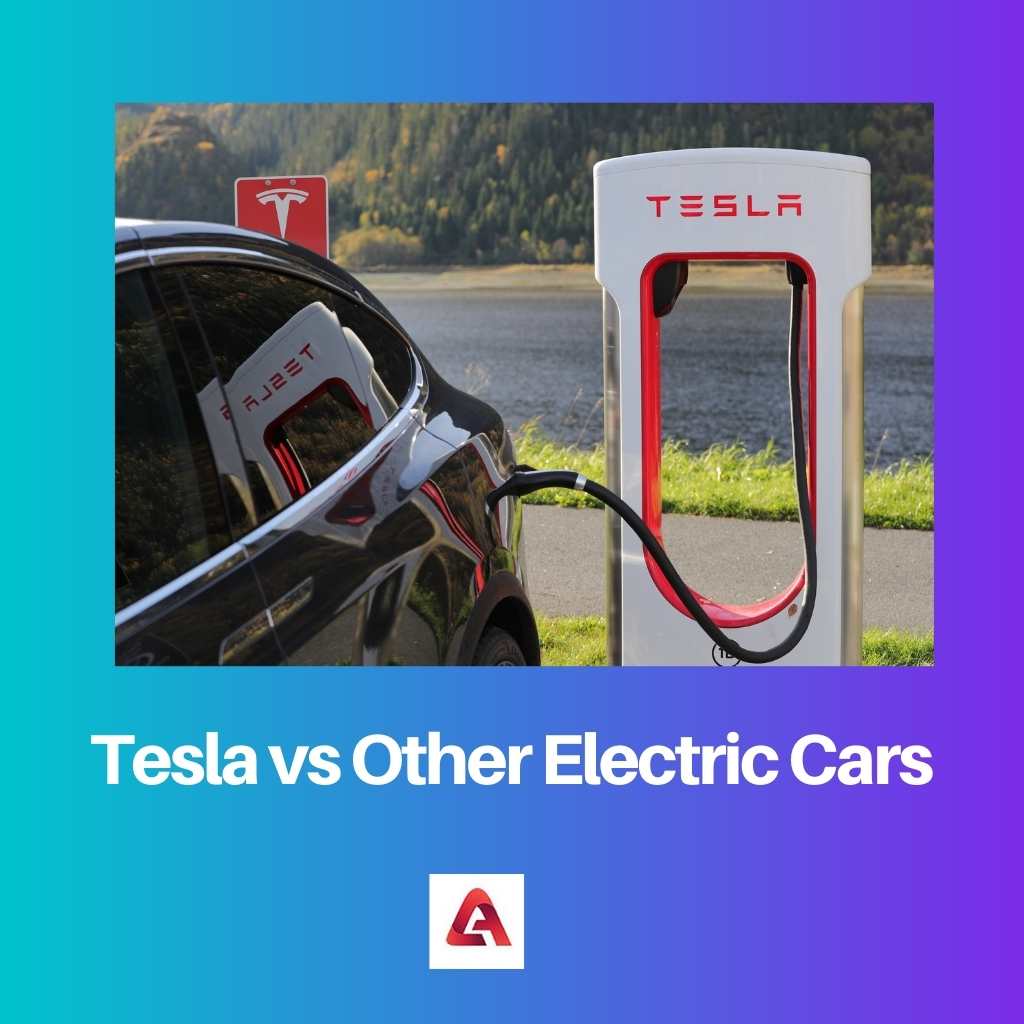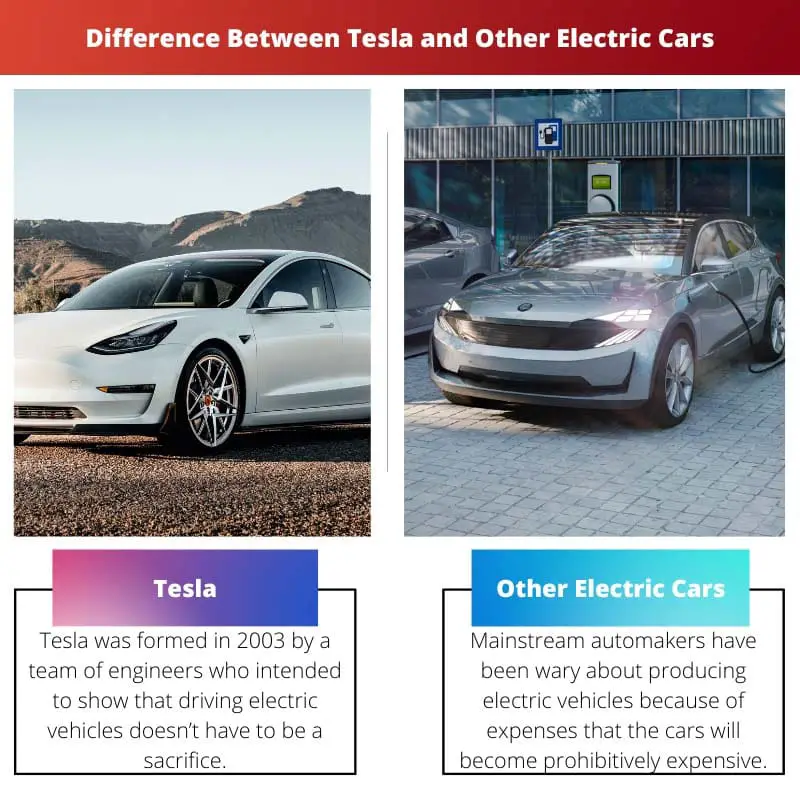Electric vehicles are becoming more popular. There are numerous causes for this, including increased security and automobile emissions requirements, technological advancements, and altering customer requirements.
Although Tesla Motors Inc. (TSLA) is responsible for much of the public’s acceptance and enthusiasm for electric vehicles, still other companies are vying for a piece of the pie.
Key Takeaways
- Tesla is a well-known brand of electric cars that offers various models with high-end features and performance.
- Other electric car brands, such as Nissan, Chevrolet, and BMW, offer cheaper models with lower ranges and fewer features than Tesla.
- Tesla’s charging network and software updates set it apart from other electric car brands and contribute to its high market value.
Tesla vs Other Electric Cars
Tesla’s Supercharger network is a significant advantage over its competitors, offering fast charging capabilities for Tesla owners in many locations around the world. Tesla has an autopilot system that is considered to be one of the most advanced driver assistance systems on the market.

Elon Musk, a successful entrepreneur, is the CEO of Tesla Inc., an American electrical automobile and powertrain developer, producer, and distributor. The company is based in Palo Alto, California, and was created in 2003.
Tesla has been able to achieve profitability by concentrating on high-end electric automobiles. When it concerns luxury electric vehicles, Tesla reigns supreme.
Hyundai, Honda, Kia, Volkswagen, Mazda, and Volvo are among the newcomers to the electric vehicle market.
Conventional automakers are expanding their hybrid gasoline-electric vehicle and pure electric automobile options, such as the Nissan Leaf.
But still, Tesla automobiles have a certain elevated cache that has yet to be replicated by other automakers.
Comparison Table
| Parameter of comparison | Tesla | Other Electric Cars |
|---|---|---|
| Sale model | Directly to customers | Franchised dealerships |
| Charging | Own proprietary Supercharger network | Limited — sometimes confined to disparate third party networks |
| Battery power | Tesla’s Model S has a range of up to 412 miles, depending on the specific model | The closest competitor is Ford’s Mustang Mach-E Extended Range model |
| Production capacity | Low production capacity due to its business model | Can be produced at a higher scale |
| Supply and demand | More demand and less supply | Supply is not a constraint but demand can be |
What is Tesla?
Tesla was formed in 2003 by a team of engineers who intended to show that driving electric vehicles doesn’t have to be a sacrifice – that they can be better, faster, and more exciting to drive than gas vehicles.
Tesla now manufactures not only all-electric automobiles but also renewable energy production and infinitely expandable storage systems.
Tesla considers that the faster the world transitions away from fossil fuels and to a zero-emission tomorrow, the better.
The renewable energy movement is helping to stimulate demand. Tesla automobiles are all-electric, which means they don’t require fuel, which emits greenhouse gases, and they don’t emit carbon dioxide directly.
Carbon dioxide is emitted by the electrical generating required to power the car’s batteries, which stays true.
Tesla’s sleek, futuristic look, as well as its high-tech user interface and dashboard, which incorporates an outstanding all-digital, touch-sensitive display, are driving demand.
Tesla automobiles are certainly in high demand. Every month, it appears that the business is breaking new sales records.
Despite the high demand, there is a manufacturing constraint, resulting in an increasing backlog of back-ordered vehicles.
Tesla, unlike traditional auto businesses, lacks the production capability to satisfy existing demand promptly. Basic economics indicates that the price would be pushed up since demand surpasses the present supply.
Tesla appears to be bound by supply rather than demand.

What are Other Electric Cars?
Mainstream automakers have been wary about producing electric vehicles (EVs) because the expenses are so huge that the cars will become prohibitively expensive.
However, some of these businesses, such as Ford, Toyota, and General Motors, have already introduced or are planning to debut all-electric vehicles to compete with Tesla’s models.
However, they will not all be ultra-luxury cars.
Traditional automakers have managed to sell electric vehicles in the past, but that could alter now as Ford ramps up competitiveness in the crowded electric-powered vehicle market.
Ford’s commitment to electric vehicles, trucks, and SUVs is paying off handsomely.
The Mustang Mach-E version from the Detroit-based firm was even awarded “Electric Vehicle of the Year” by an Automobile magazine after it scored third in sales amongst electric sport utility cars in the United States.
The Volkswagen Group is among the market titans that have always promised to change this. Volkswagen’s ID series has silently been making gains into the sector a generation after Tesla entered the picture.
The 82-year-old Volkswagen, one of the world’s greatest corporations, has weathered numerous boom-and-bust phases, not to mention dictatorships, wars, and the partition and reunification of its host nation — making it exceptionally good at attaining long-term goals like this one.

Main Differences Between Tesla and Other Electric Cars
- Tesla sells its cars directly to customers while other electric cars are sold through franchised dealerships.
- Tesla has its proprietary Supercharger network while other electric cars have a limited charging network, sometimes confined to disparate third-party networks.
- Tesla’s Model S has a battery that ranges up to 412 miles, depending on the specific model while for other electric cars the closest competitor is Ford’s Mustang Mach-E Extended Range model.
- Tesla has a low production capacity due to its business model while other electric cars can be produced at a higher scale.
- Tesla has more demand and less supply while for other electric cars supply is not a constraint but demand can be.

- https://www.sciencedirect.com/science/article/pii/S1462901114001208
- http://legacy.veva.ca/papers/HowFarWeDrive_v1.2.pdf
